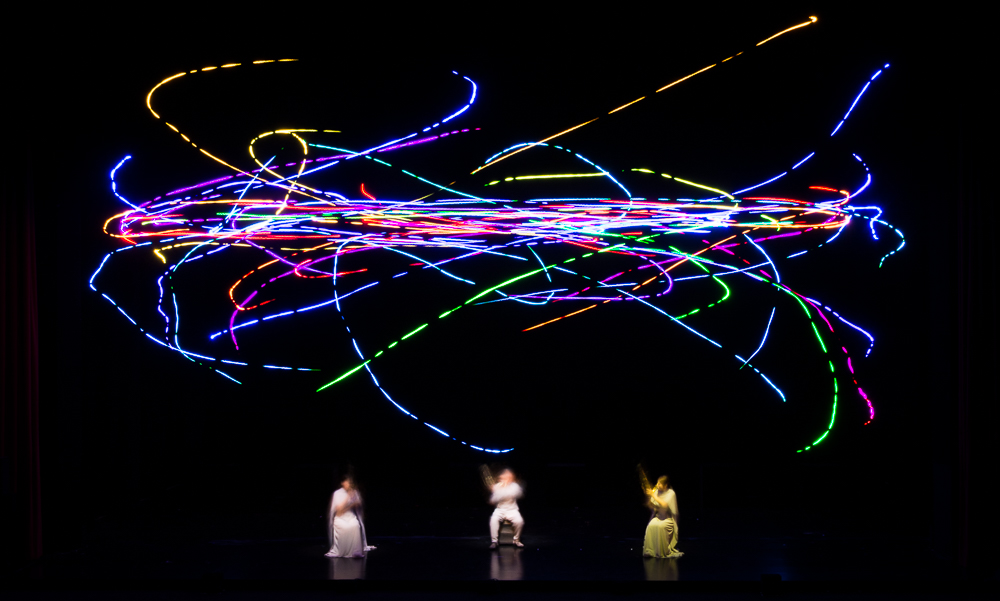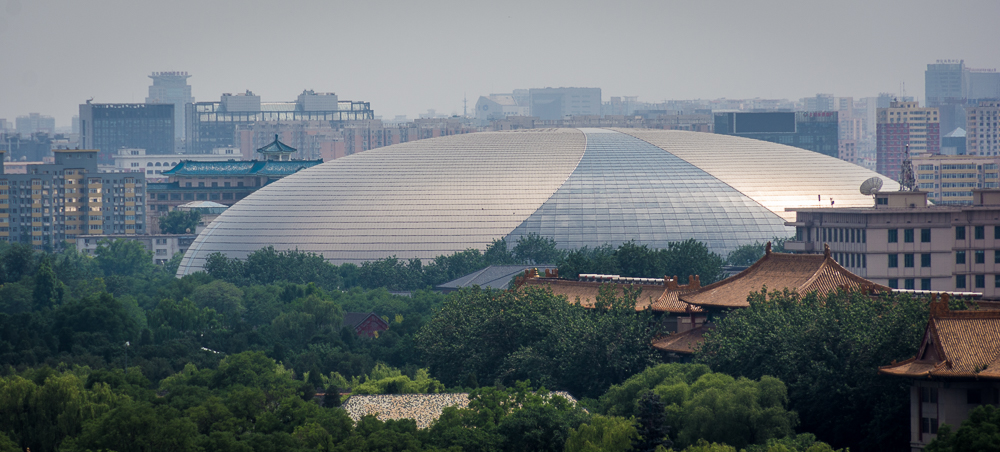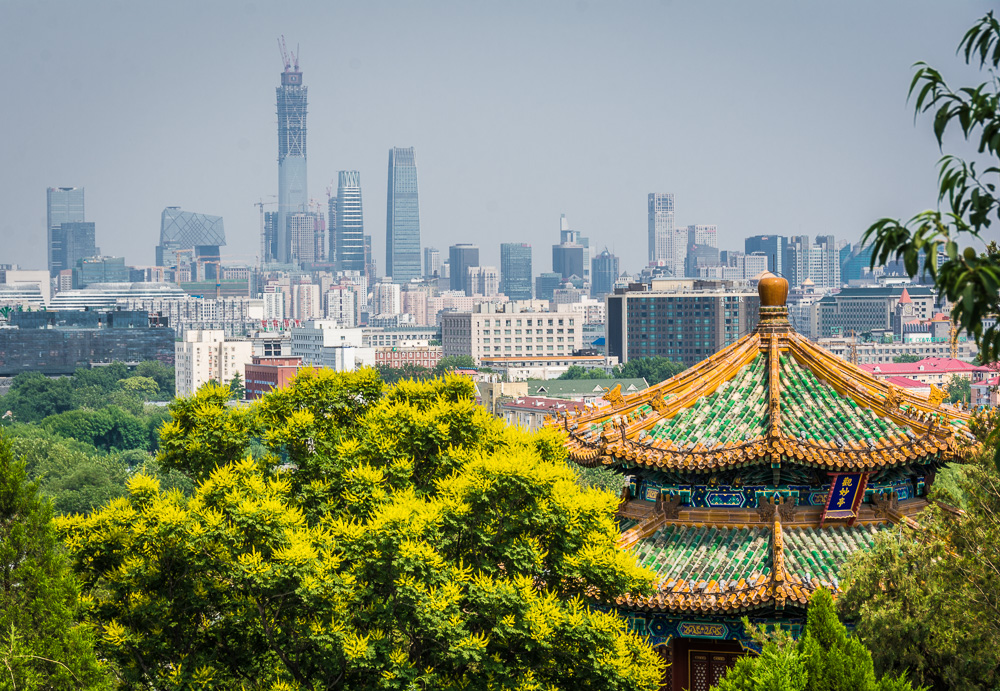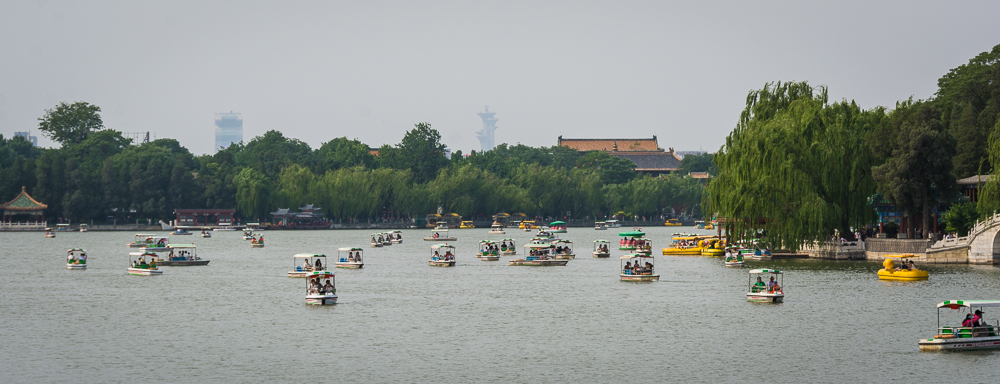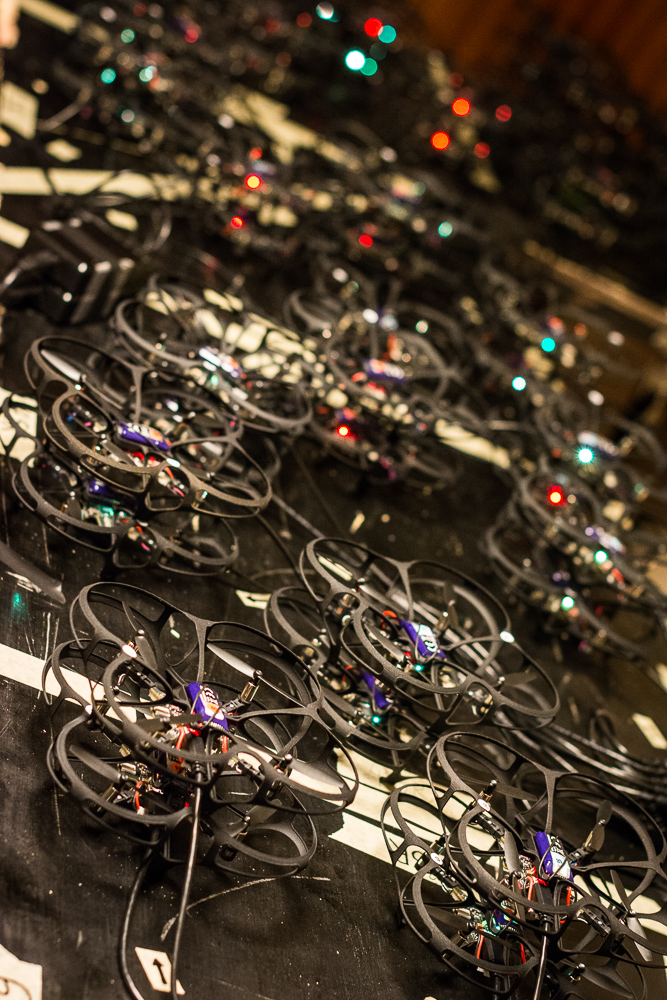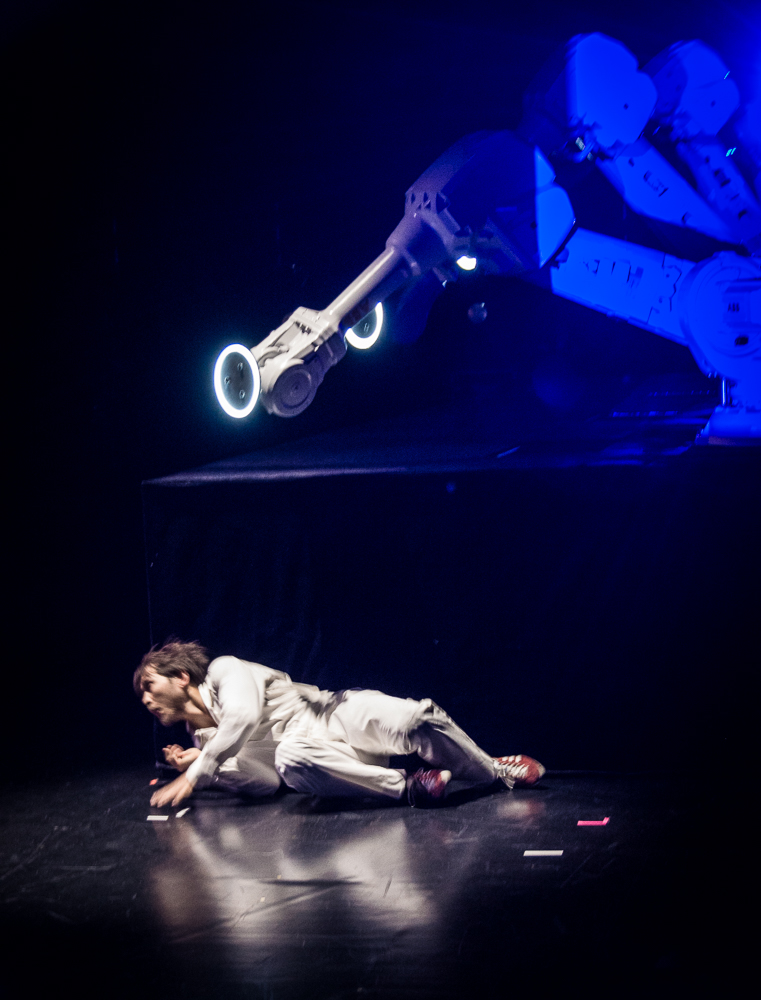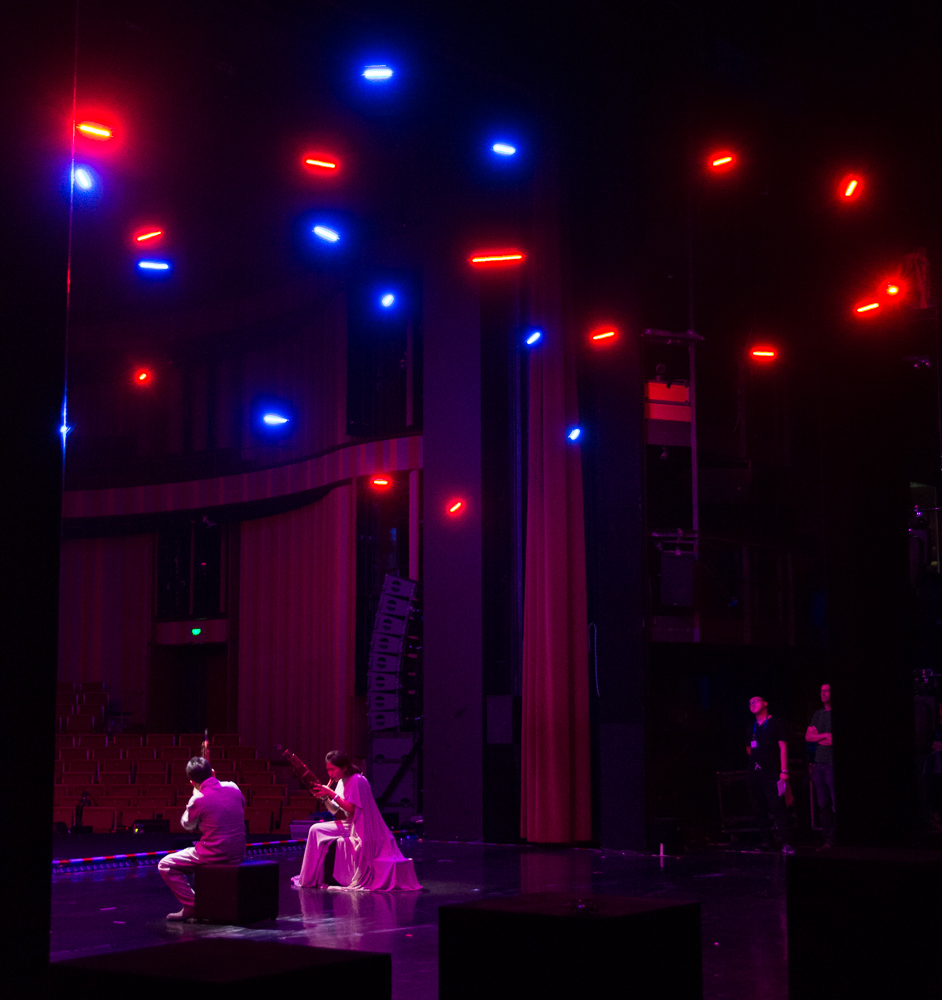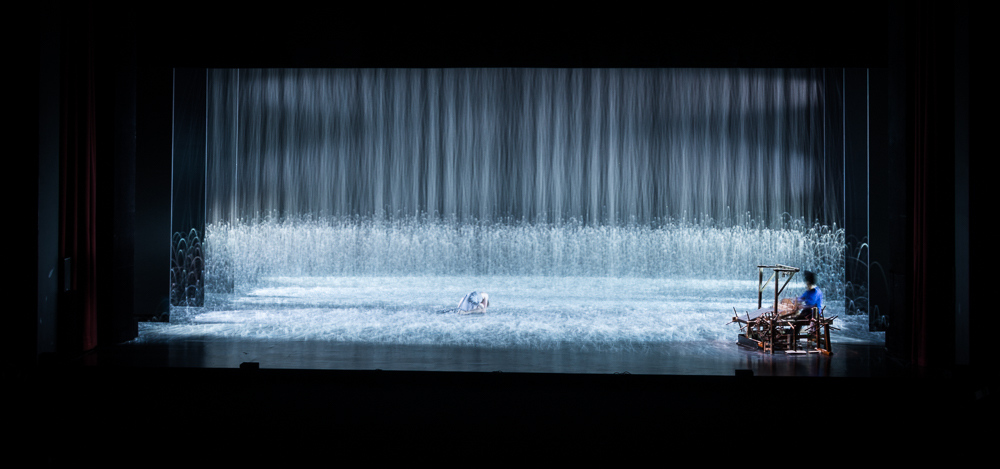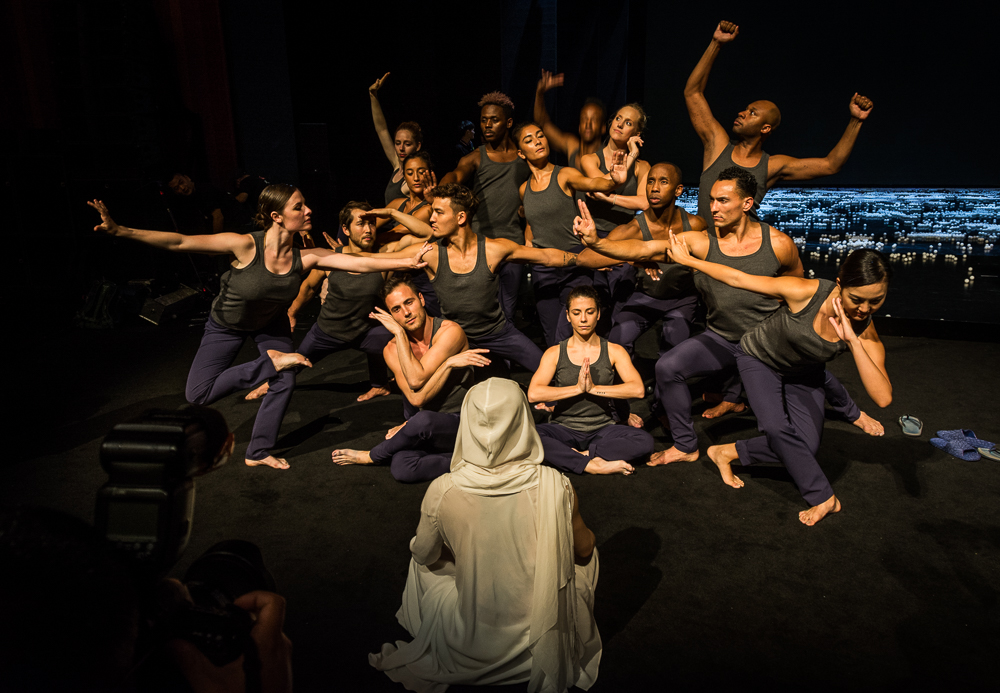In May, I spent close to two weeks in Beijing for work. Even though the pictures from that trip may suggest otherwise, there was actually work involved also ;) To be precise, we were doing the first rehearsals for the show “2047 Apologue”, which was to be shown at the National Centre for the Performing Arts (or NCPA) for three evenings in June. So – early June, I went back to Beijing for quite a bit less sightseeing, and quite a bit more work. The show was a concept theater, directed by the famous Chinese director Zhang Yimou, that seeked to investigate the future relationship between people and technology, by combining traditional Chinese performing arts, with state-of-the-art stage technology. And at Verity Studios where I work, we can provide good amounts of the latter ;) Our main competence is doing drone-shows – for instance a large fleet of small drones with lights, flying around in complex patterns – more on this later! In any case, since it’s a bit hard to explain everything in pictures only (luckily I got a few!), I thought this trip was worthy of a slightly longer write-up…
On the second trip, we started out at a rehearsal site in Beijings 798 Art district – and when I say rehearsal site, I actually mean old re-purposed oil-tank. With air condition installed, it wasn’t actually as bad as it may sound, and in any case our slightly crazy work-hours (which didn’t help at all in our already jet-lagged condition) would have been tough no matter the site. I never got around to get a good picture (or any picture, actually) of the tank from the outside though, which is probably what annoys me the most in hindsight ;) I did get to visit the Wangjing SOHO complex though, which was more or less next to our hotel – some interesting architecture, and lots of places to get some food – I particularly enjoyed one of the build-your-own-noodle-soup places.
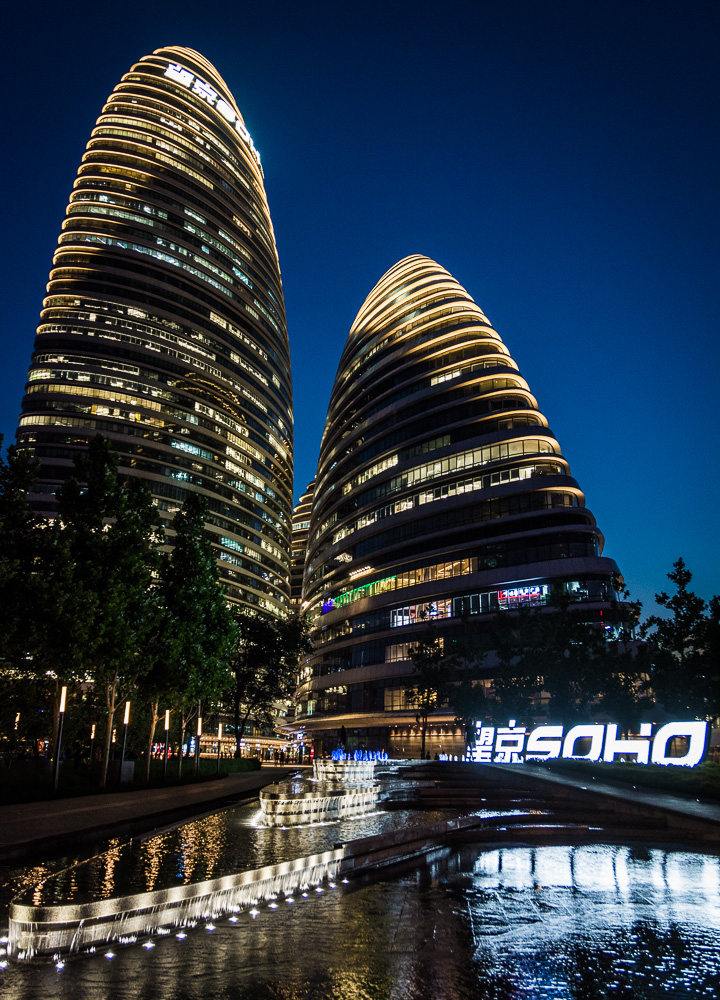
The Wangjing SOHO complex
Back to work though… Inside the rehearsal oil-tank, a 1:1 model of the stage we would be performing on at the NCPA had been built, complete with curtains, lights, trusses, and soon also a drone-show system… We got everything set up and working, and in the following days completed rehearsals together with the many other teams taking part – laser and kinetic lights, dancers, holograms, actors, industrial robots (more on all these later), and several groups of musicians, including the trio that would be providing the music for our drones. Headed by two-time grammy-winner Wu Tong, they all played the ‘sheng’ – and they sure did it well! Not only were they spot-on with notes and timing, the music also proved to be very well-suited to our drones, and even managed to not become too annoying after listening to the same tune for almost two weeks straight ;) And on top of that, Wu Tong was as nice a guy as he was a skilled musician.
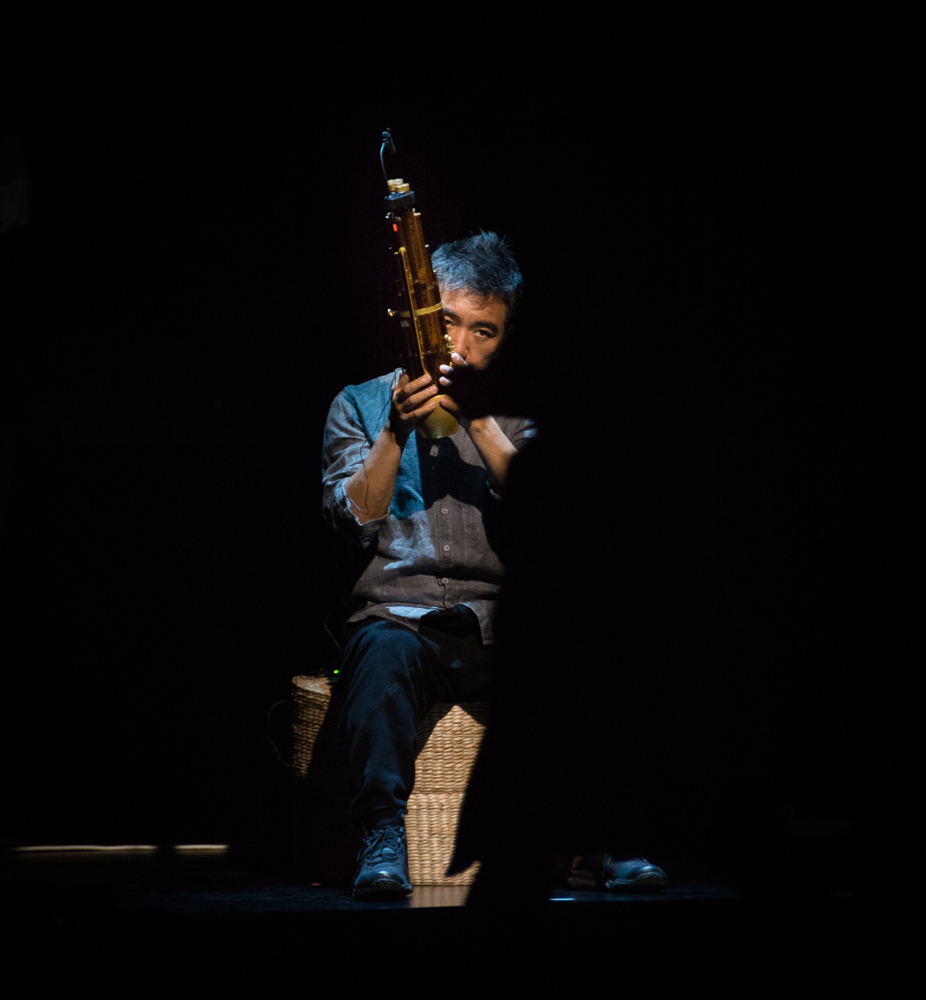
Wu Tong doing a sound check with his sheng
After some initial troubles getting especially the transitions between the many scenes nailed down, at the end of the first week we had completed multiple complete rehearsals, and we were feeling quite confident about our part, as we prepared to move into the NCPA. This also meant a move to a different hotel, to avoid a probably one-hour commute each way – and – the move meant that we even got to take Sunday off! I had seen most of the sights I really wanted to see on the last trip, except for one: Jingshan Park, right across the street from the exit from the Forbidden City. Not so much due to the park itself, but mostly because it provided something otherwise rare in Beijing – elevation, in the form of a 45m artificial hill. So for my day off, I went for a hike to get some very nice views over the Forbidden City in particular and Beijing in general – and the NCPA was nicely positioned not too far away also.
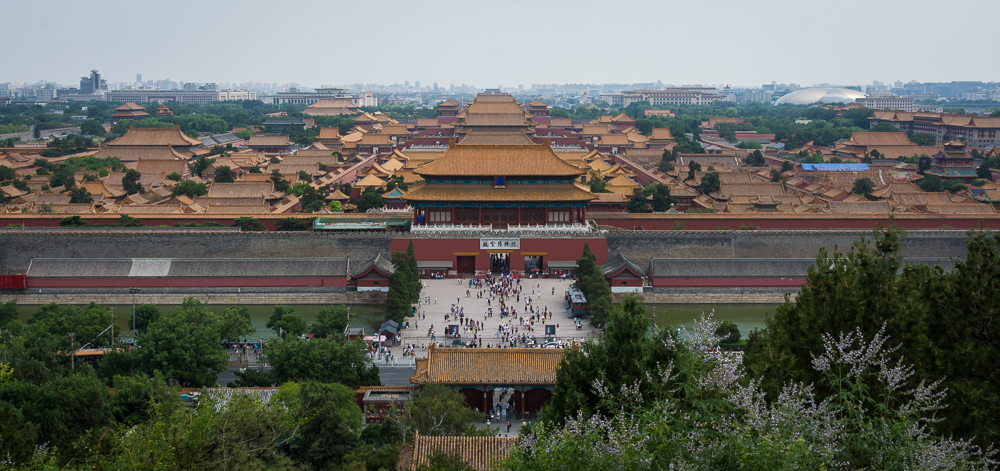
View over the Forbidden City from Jingshan Park – notice the NCPA in the background to the right (it’s the egg-shaped titanium dome)
The next days were spent getting settled in to the NCPA. The NCPA is probably one of the, if not the, most prestigious theaters in China, and even though we “only” were placed in the Theater (the third-largest NCPA stage, after the Opera House and the Music Hall), just being able to call that your office for the week, is still an experience on its own. We had our own dressing room, complete with fancy mirrors and a private bathroom (which was about an infinite step up from what we had at the oil-tank), and with access to the (still very impressive!) NCPA lobby, came also the possibility of easily getting a decent cup of coffee, and some quite good chocolate-muffins. Things were looking good! However, with all the technology that had to be installed in the theater, it took a bit longer than expected before the stage was clear enough to allow us to install our system – but when the first full rehearsal came along Wednesday evening, we were ready (although only just!).
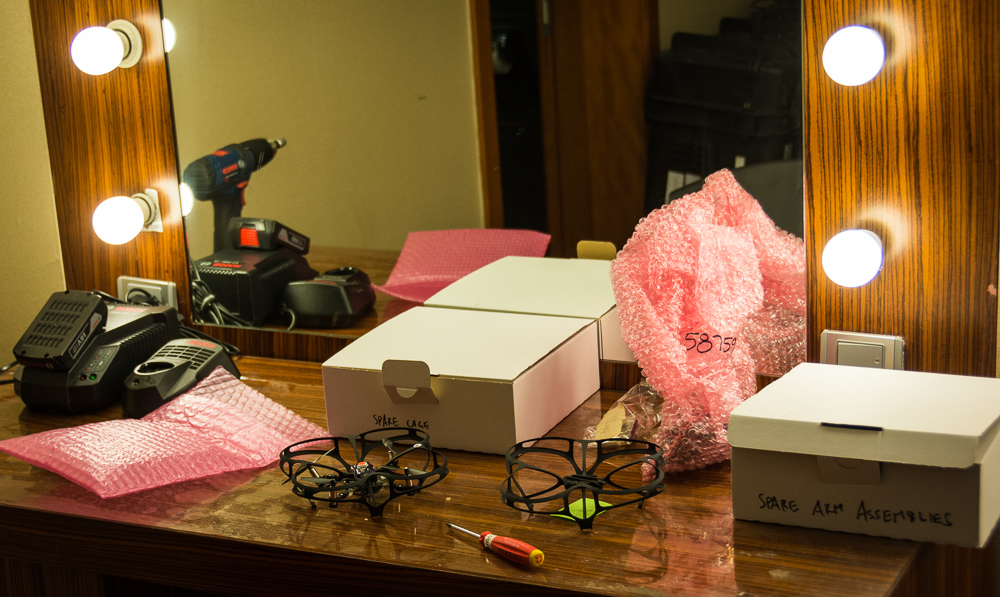
Drones and power tools were probably a new experience for the dressing room…
So – a bit more about the show itself – obviously, this will contain some rather huge spoilers, so if you plan on going to see the show, it would probably be a good idea to stop reading now – you have been warned ;) But, to the point: As a concept theater show, 2047 Apologue consists of 8 separate acts, without any direct story binding them together, but all centered around the relationship between humans and technology – illustrated by combining traditional Chinese performing arts and advanced stage technology. As described by the director:
In this dialogue between ancient culture and modern technology, we experience puzzles that come with the rapid progression of technology, and reflect on it – what will be the future relation between human and technology?
The first act consisted of a band of long tune and throat singers, that also played traditional Mongolian instruments. In the background, a kinetic sculpture, consisting of a piece of cloth on a specialized wind machine. On the face of it, neither of these may sound super exciting, but both were very interesting once you had the chance to see and hear it on stage. The musicians did really well, and how they produce those sounds, I will never know (even though one of the guys tried teaching me!) – a rough description would be something like a didgeridoo – but without actually using a didgeridoo(!). The kinetic sculpture proved that sometimes something very simple can provide very beautiful results – with the right lighting, the piece of cloth looked like an other-worldly being while dancing in the airstream. This act did not really tell a story as such, but helped set the stage to guide the audience into a different world.
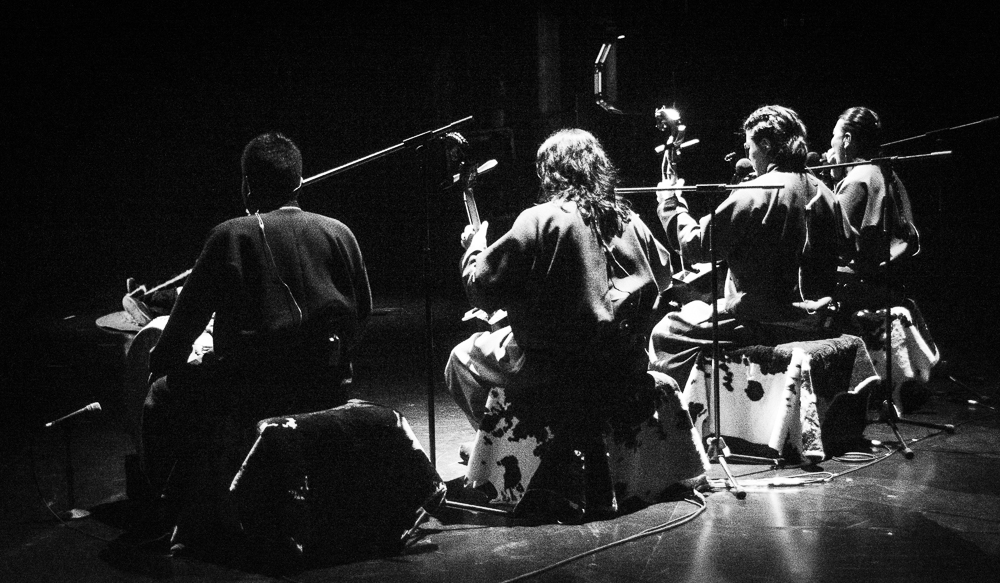
Act 1: The long tune and throat singers – lighting conditions weren’t fantastic, so sadly didn’t get better pictures neither of the singers nor of the kinetic sculpture… (in the case of the latter, pictures probably wouldn’t have done it justice in any case though ;)
The second act combined three elements – a guqin (a plucked seven-string Chinese musical instrument) player whose music was illustrated through a laser projector, and with a dancer/artist performing within the projection – giving the impression of the dancer being inside the instrument. Initially he is in control, and plays around with the various possibilities – each string illustrated by the laser projector. However, soon he looses control, and ends up being caught inside. Realizing that there is no way out, he commits suicide (I think). This is the first of several acts with a rather pessimistic outlook on technology – or at least, a cautious one.
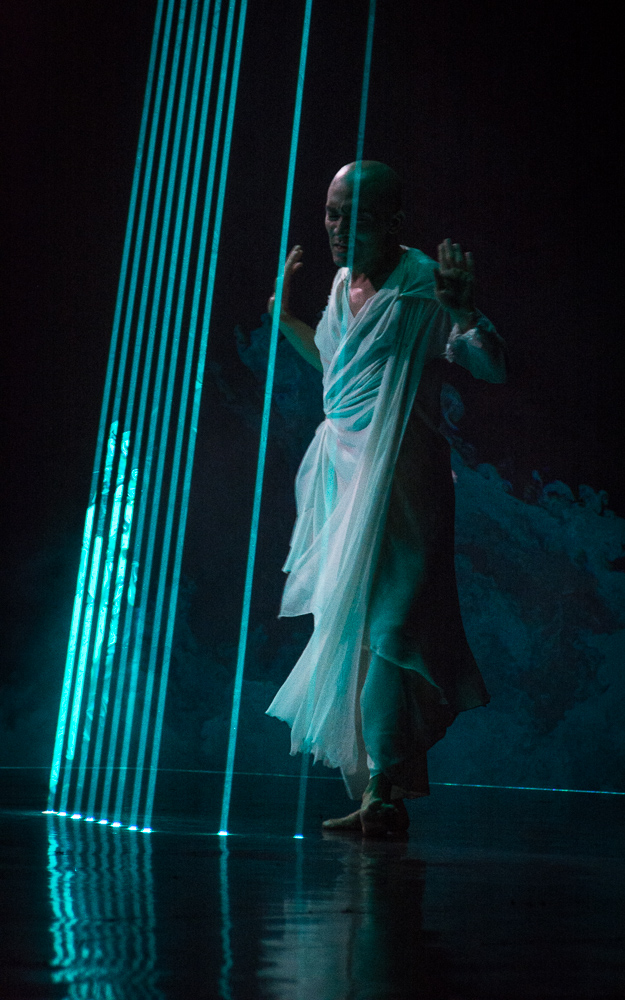
Act 2: About to realize that he’s caught inside…
The third act took a bit of explanation (especially of what the first part was actually about) before it made sense to me. It consists of two parts, where in the first, two actors enact a traditional Chinese story about two men caught in a house at night. They hear that other people are coming for them, and thus blow out the single candle lighting their house to better hide. However, in the darkness they then mistake each other for the people coming after them, and end up fighting each other. The second part then has a number of dark-clad teenagers walking on stage, each holding an iPad with a picture of a face in front of their face. The idea of this act is to show how in the past, people were fighting each other due to too little light – now, we have an abundance of light (from the screens), but do we really see each other anymore? An interesting commentary on something that is already relevant in the present. And slightly ironic to see the iPad teenagers spending most of their time backstage looking at their phones during acts…;)
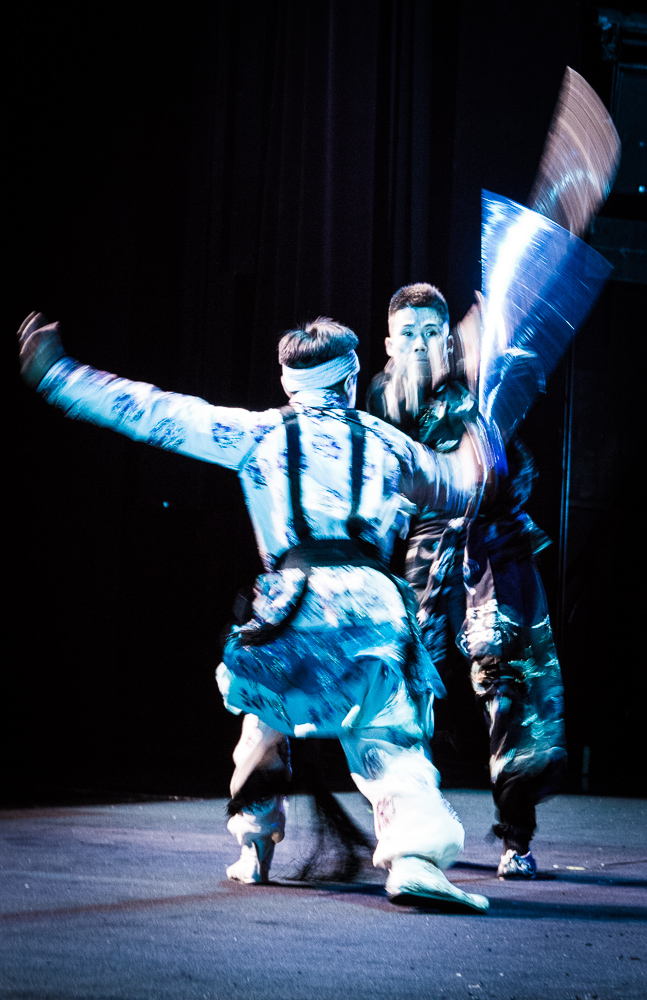 |
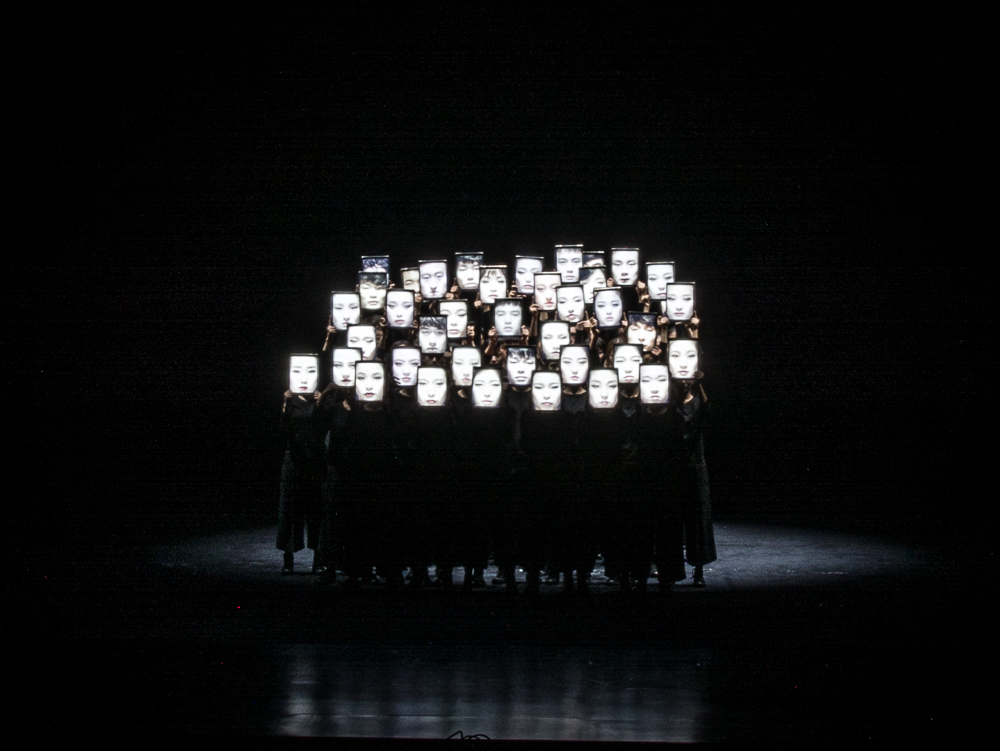 |
|---|
Act 3: Left: The two fighters in action – Right: The iPad teenagers
The fourth act starts with a band of four Chinese marionette performers, and a labcoat-clad spectator. The spectator seems to get an idea from the marionettes, and as soon as these leave the stage, he goes to the back and unveils four large, seemingly sentient, industrial robots. He brings back the marionette performers, to show these to the robots – and they apparently like it. As soon as the marionettes leave the stage, the robots try out their new-found knowledge – on their creator. The rest of the act has him struggling to escape the controlling grasp of the robots – and ultimately failing. A story similar to the second act, and pretty uncomfortable to watch (although very well acted and played out!).
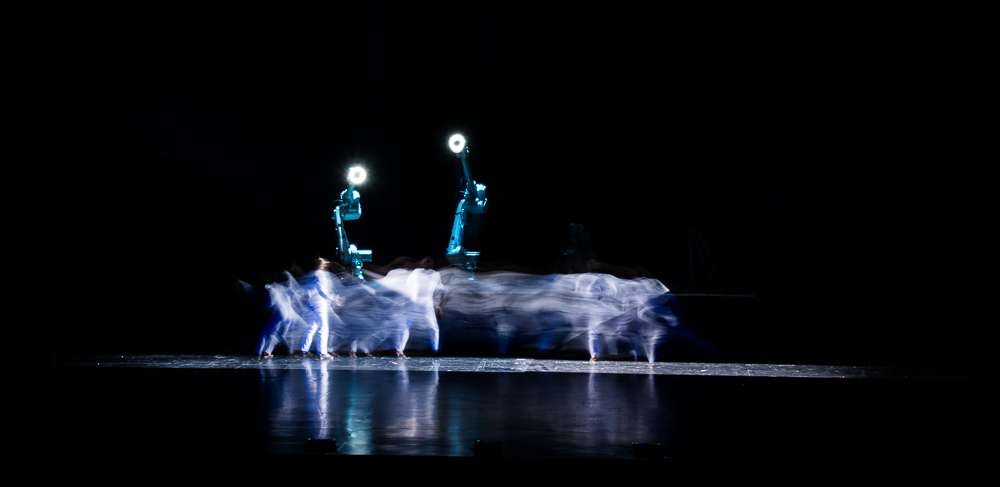
Act 4: Unveiling some robots (10 second exposure)
From the fifth act, things get a bit more fuzzy for me. At this point I was usually backstage, preparing drones for the (spoiler alert;) seventh act. And especially the fifth and the sixth acts required onlookers to be in front of the stage to really see what was going on. Oh well. In any case though, what I did get, was that the fifth act consisted of a hologram projector, a live dancer, and a musician. The dancer danced inside the hologram, and, through various forms of stage trickery, changed between the live version, and a hologram version. What the hologram showed I’m a bit unsure about, as this is only visible from the front (polarized light and all that). I could see the dancer and hear the music though – and both were brilliant. Especially the dancer, a young girl, dancing with a holographic guy was mesmerizing. She had a several minute long routine of very different moves that she somehow remembered, and (I think at least – couldn’t really see the hologram ;), managed to synchronize to the holographic projection. She was however (as the only artistic performer I think) also on stage for every single rehearsal – even the pure technical ones – so hats off for that! I never completely understood the main idea about the act, but I would imagine it’s something about real and virtual identities merging, and it not always being apparent which is which. I must also admit though, that initially my main focus was not on understanding the idea behind the act itself, but rather figuring out how the hologram and the appearing and disappearing of the dancer worked – I am an engineer after all ;)
In the sixth act I was on stage! Admitted, I was behind a very large box (about 10m wide, and probably 2-3m high and deep), but on stage none-the-less. The box had windows in the front, an 11-man strong Chinese folk-band playing drums, cymbals and suonas on top, and an international group of modern dancers performing inside it. Sadly the box wasn’t transparent from the back, so I could only hear a lot of noise from the dancers inside the box – and the rather loud music. The band definitely looked as if they were having lots of fun though! This was the only act to not feature any kind of fancy technology, but instead relied only on the musicians and the dancers – and a large amount of blue paint that was splashed against the windows at the end of the act :)
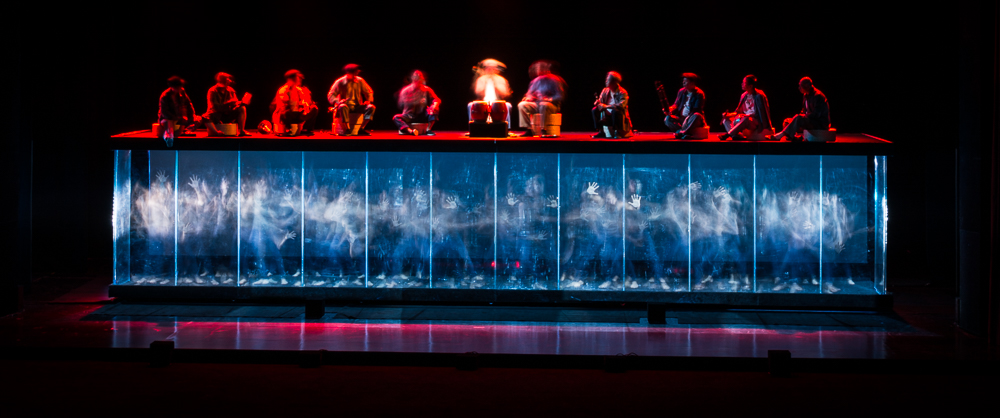
Act 6: The box with dancers and musicians. Again a 10 second exposure, so it looks a bit more spooky than it actually was ;)
The seventh act was where everything got really exciting though. As the curtains were pulled aside, Wu Tong and his two fellow sheng-players sat in the middle of the stage, and started off slowly – with me and my colleagues backstage, anxiously waiting for the reassuring sound of the three initial Lucie microdrones taking off. Even though the whole system had been performing admirably up to the actual show, I couldn’t help being quite relieved when we saw the three drones in the air – one above each musician. Soon after, eight additional drones took off, flying in a half-circle around the musicians and the three first-movers – as their lights turned on quickly one after another, you could even hear the audience doing an “oooohhh” – a pretty good feeling for us! To me, the movement and color of these actually ended up somewhat (as much as is possible with just eight point-shaped lights) resembling a Chinese dragon flying around the stage. This went on for a minute or two, before the musicians started gaining a bit of momentum – the eleven initial drones had landed, and suddenly lots of more drones started appearing from the back of the stage. So many Lucies were in the air for the finale that they were difficult to count – swirling around the musicians in a multitude of colors, while the music was nearing its climax. Seeing so many drones in the air is something that is difficult to describe. It’s a bit like fireworks, in the sense that while you can appreciate the colors and the beauty when seeing it on pictures or video, seeing it live gives so much more. And the audience seemed to agree – as the drones landed and Wu Tong had played the last notes, we got a big applause and even a good bit of “woohoo” – on all three evenings! The feeling of relief that everything went well technically, combined with a happy audience was a nice rush! And as curtain calls with all performers and groups had been added (mainly to provide a bit more time for the technical transitions), after a bit of frantic picking up of all the landed Lucies before anyone managed to step on one, we even got to go out in front of a packed (I think at least – with the spotlights, it was difficult to see;) theater and do a bow together with the musicians.
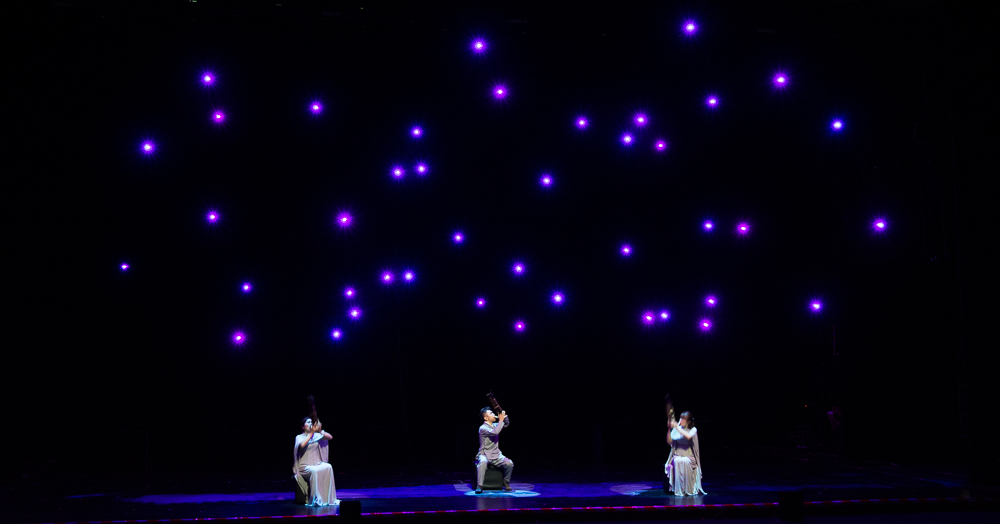
Act 7: Drones!
Next task for us was to get the drones back on their chargers in our dressing room. This had to done quickly to avoid draining the batteries too much, so we didn’t really get to see the eight act before the last day, where a bit of extra wear on the batteries wouldn’t matter that much – we were done after all. I had really been looking forward to seeing the last act, as it was using kinetic lights – 640 (if I recall correctly) ~15cm balls suspended in a grid from the ceiling, and able to move up and down, and light up in any color at the same time. Below the lights, a dancer was performing, and in the front of the stage, a traditional Chinese weaver was weaving on a 200 year old weaving machine. The idea here was similar to act 2 – the kinetic lights would represent the weaving machine, with the dancer performing inside it. First, the dancer could control and play along with the lights, but again, technology takes over, and the dancer ends up being caught, with everything (literally!) coming down around her at the end.
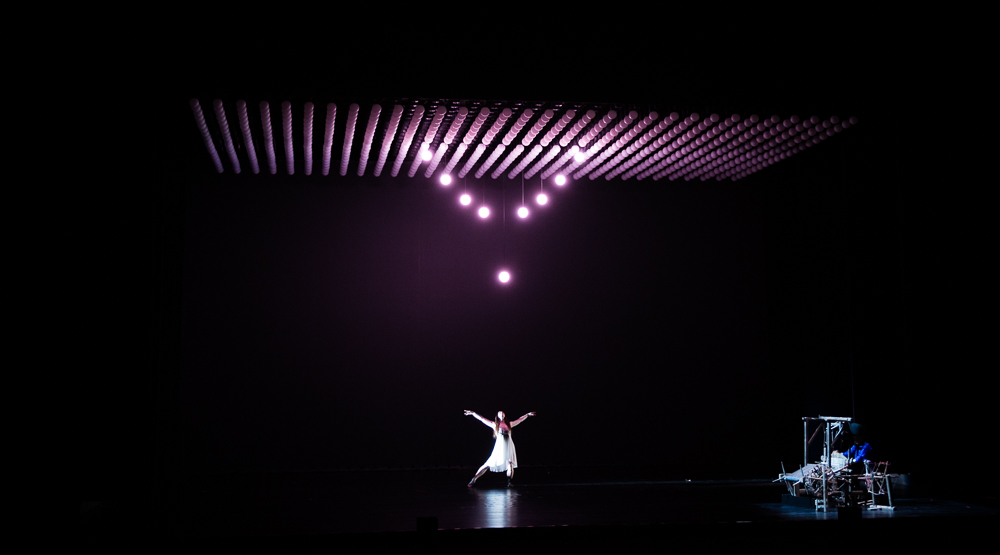
Act 8: Kinetic lights – all is still well…
All in all, a very impressive show, with some fantastic performances from everyone on and off stage. It required two weeks of very hard work on-site (and a lot of great work done by everybody back in the office leading up to the show), but the feeling after having done three very close to flawless shows was amazing nonetheless. It was clear that this was shared by basically everyone involved, as the mood on stage after the audience had left the theater was very relaxed and fun, with everybody taking pictures and selfies and just generally enjoying the shared success. This couldn’t last all night though, as we had to get everything packed down before leaving for the hotel. Luckily we were able to do this in a couple of hours, so it didn’t end up too late before we were back at the hotel enjoying a well-deserved beer, with some of the other performers. I also tried out a bit of throat-singing after being instructed by a couple of the singers from the first act, using just sounds and gestures, as they didn’t really speak any English, and I didn’t really speak much Chinese. Fun though!
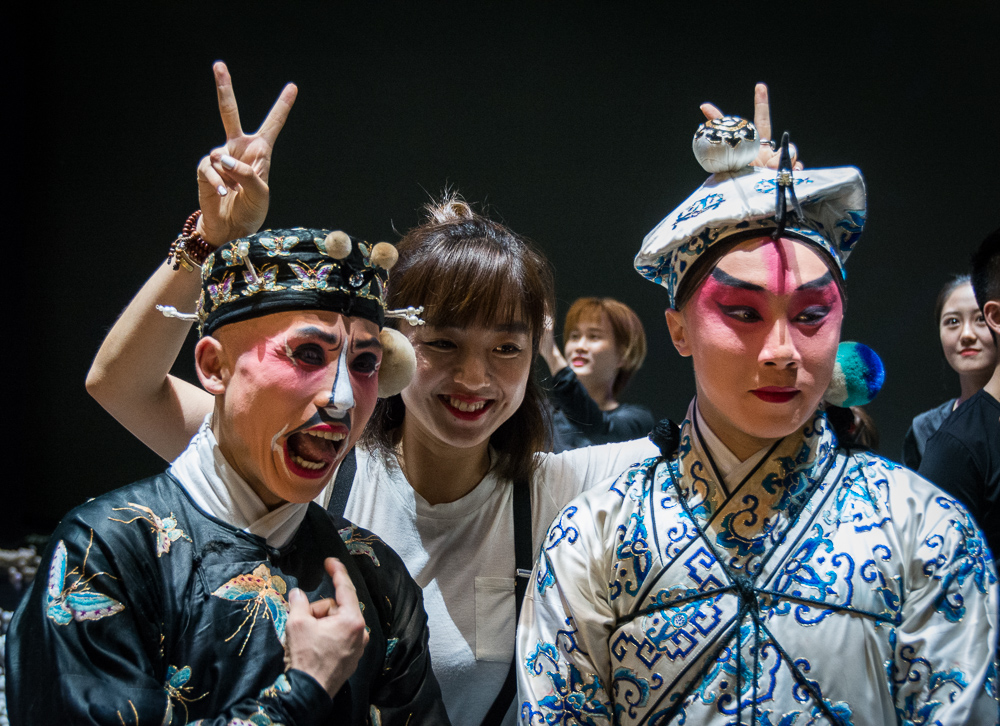 |
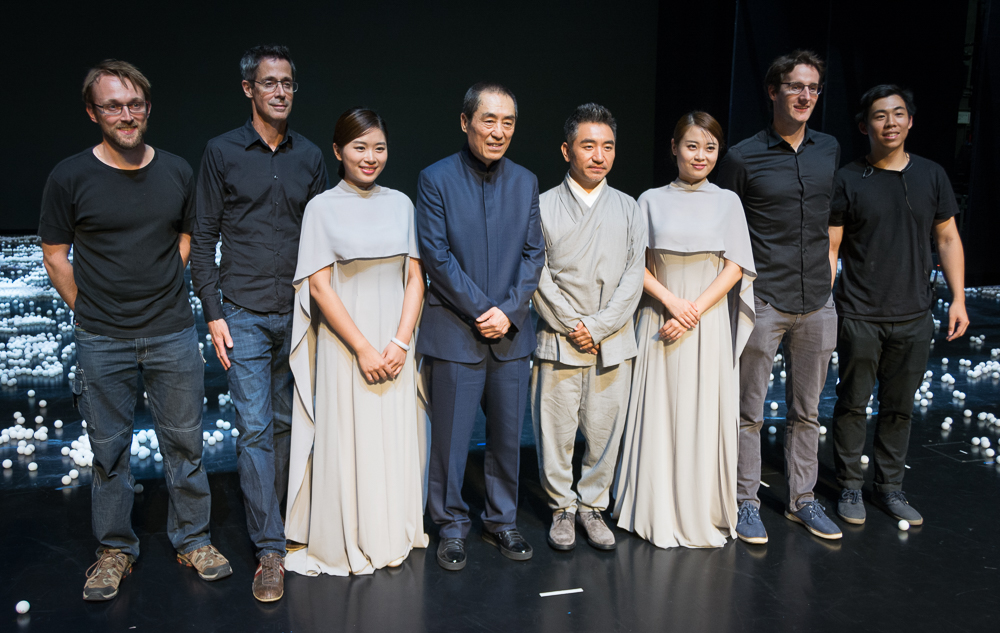 |
|---|
Left: Having fun on stage after the last show / Right: The team from the seventh act (us!) with the director
When it comes to pictures, I sadly didn’t have the time (or the equipment) to do as much as I would have wanted – during the show I mostly had tasks on stage or backstage, that weren’t really possible to combine with lugging around my DSLR. I did however get some good use of the timelapse function, by positioning the camera, setting the exposure (trying to optimize for drones, obviously;), and then just hoping that the timing would be good, and the settings right. I did luckily get a couple of good shots, and the drone-optimized settings (doing 10-second exposures in the last set) provided some very interesting results for some of the other acts too – as is probably evident from the pictures above :)
Conclusion – the two weeks of hard work paid off, both in instant audience-satisfaction and also in a very interesting experience!
